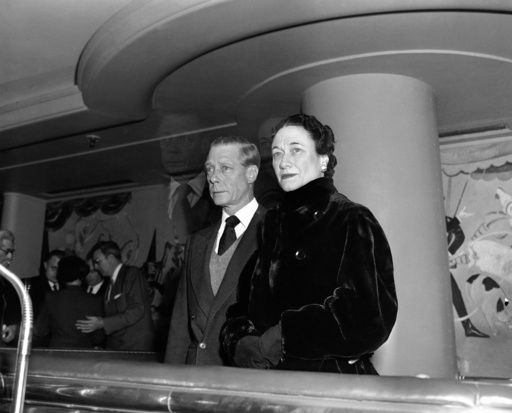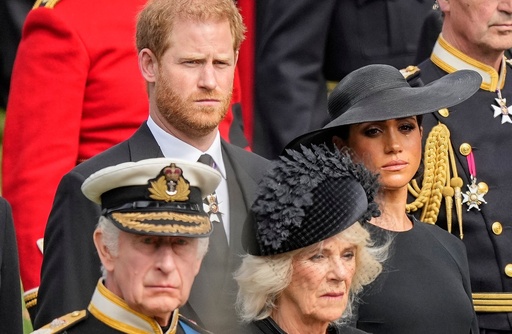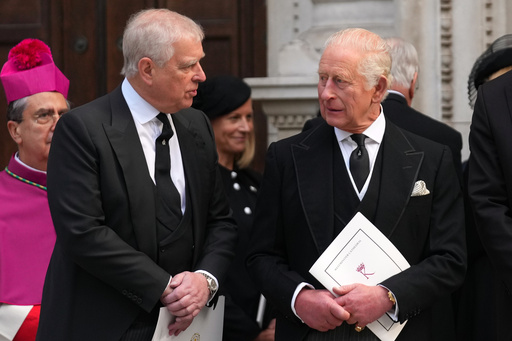Andrew's royal exit is the latest crisis for Britain's monarchy
News > National News

Audio By Carbonatix
4:12 AM on Saturday, November 1
By JILL LAWLESS and BRIAN MELLEY
LONDON (AP) — Holding prestige but not power, Britain’s monarchy is finely tuned to public sentiment.
That's been evident with the disgrace of Andrew Mountbatten Windsor, who was stripped of his princely title and his spacious home by his brother King Charles on Thursday, a banishment that has left the disgraced royal increasingly exposed to scrutiny both in the U.K. and the U.S. over his friendship with the deceased sex offender Jeffrey Epstein.
Following years of scandals related to Andrew, Charles arguably took the biggest step of his reign by seeking to insulate the monarchy from any further scandals relating to Andrew and his connections with Epstein, who took his own life in prison in August 2019 while awaiting trial on sex-trafficking charges, more than a decade after his initial conviction.
It's not the first time the current iteration of the British monarchy — the House of Windsor — has been in crisis over the past century and where the future of the institution has been threatened.
George Gross, a royal expert at King’s College London, said the most recent precedent for what has happened to Andrew is the 1917 Titles Deprivation Act, which “saw various members of loosely affiliated royals and dukes and members of the peerage losing titles if they had sided with Germany in the First World War.”
The royal families of Europe are intertwined, and Britain’s is heavily German, especially after Queen Victoria married Prince Albert of Saxe-Coburg and Gotha, with whom she had nine children.
When Britain and Germany went to war in 1914, some members of the wider British royal family found themselves on opposing sides.
Britain’s King George V changed the family name from Saxe-Coburg and Gotha to Windsor in 1917, and initiated legislation to strike out the titles of princes and lords “who have, during the present war, borne arms against His Majesty or His Allies, or who have adhered to His Majesty’s enemies.”
One target was Prince Ernest Augustus, Duke of Cumberland and Teviotdale, who was a U.K. royal and also a prince of Hanover. His title was removed for being an enemy of Britain under the 1917 act, which was enacted in 1919, once the war was over.
According to the House of Commons Library, “this was the first and only time such a title has been removed in this way.”
The relationship between Edward, Prince of Wales, and U.S. socialite Wallis Simpson was a headache that turned into a constitutional crisis. Simpson was twice divorced, and Edward, the heir to the throne, was destined to be ceremonial head of the Church of England, which did not allow divorced people to remarry in church.
The prince became King Edward VIII when his father King George V died in early 1936. He continued to say he wanted to marry Simpson, despite the opposition of the British government.
Forced to choose between duty and passion, he gave up the throne in December 1936, announcing in a radio broadcast that “I have found it impossible ... to discharge my duties as king as I would wish to do without the help and support of the woman I love.”
The news was a surprise to many in Britain, though not beyond it. British newspapers had not reported on the relationship, and American magazines had offending articles cut out before going on sale.
The abdication set the monarchy on a new course. Edward’s younger brother took the throne as King George VI. He was succeeded by his daughter, Queen Elizabeth II, and after her 70-year reign by her son, King Charles III. All doubled down on the idea that the monarch’s primary attribute should be a sense of duty — something Edward, in the popular imagination, lacked.
Edward and Wallis, now the Duke and Duchess of Windsor and suspected by some of Nazi sympathies, were sent to the Bahamas, where he served as governor. After the war they mostly stayed away from Britain, living a life of nomadic luxury.
The death of Princess Diana — the ex-wife of Charles — in a car crash in Paris in 1997 at the age of 36 shocked the world and left her family, including sons William and Harry, then 15 and 12, in mourning.
The strength of public feeling caught the royal family by surprise. Mounds of floral tributes piled up outside the gates of Buckingham Palace and Diana’s Kensington Palace home to mourn a princess who had been ostracized by the royal family after her divorce from Charles in 1992.
The queen was at Balmoral in Scotland on her summer holiday with her husband Prince Philip, Charles, William and Harry. The family kept their grief private and stuck to routine — taking the ashen-faced boys to church on Sunday morning — and the queen did not issue a statement for several days.
She was advised to make a public display of grief by Prime Minister Tony Blair, who perfectly caught the public mood with his own tribute calling Diana “the people’s princess.”
After newspaper headlines urging “Speak to us Ma’am” and “Show us you care,” the queen made a live televised address to the nation on the eve of Diana’s funeral.
“What I say to you now, as your queen and as a grandmother, I say from my heart,” the queen said, acknowledging the country’s grief, praising Diana and promising to cherish her memory.
Until the Epstein scandal reared up again last year, Andrew had been trying to regain favor with the family. He may have benefited indirectly from the trouble with Prince Harry, who was the source of most of the drama at the time outside of the family’s high-profile medical problems.
Harry became estranged from his father and older brother, Prince William, heir to the throne, when he and his wife, Meghan, stepped down from their working roles and moved to California in 2020. The couple famously aired their grievances with the royal family in a tell-all interview to Oprah Winfrey and a revealing Netflix series. Harry, also known as the Duke of Sussex, then fueled the tensions by revealing personal conversations in his memoir, “Spare.”
Harry also broke from royal protocol in turning to the courts to sort out his legal problems. He became the first senior royal to testify in court in more than a century in his successful phone hacking lawsuit against the Daily Mirror.
A failed legal effort to restore his police protection detail that was stripped from him when he left royal work, though, was seen as an attack on his father’s government.
When the courts finally rejected the lawsuit, it provide a chance for a reunion between father and son. The two shared a cup of tea at Charles’ London abode, Clarence House, in September. It was their first meeting in over a year. It lasted less than an hour.










